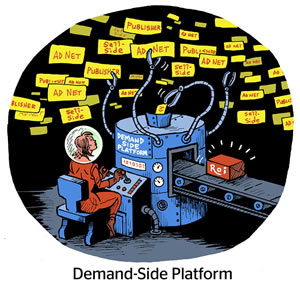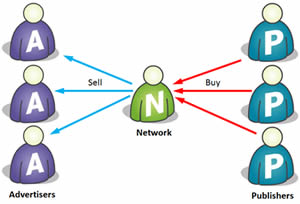Difference between DSP and Ad Network
Key difference: DSP stands for demand-side platform. It is a buyer’s side platform. It allows digital advertising buyers to manage multiple ad exchange and data exchange accounts through one interface. Ad networks, on the other hand, operate somewhat differently. An ad network connects advertisers to web sites that want to host advertisements. It effectively matches ad space supply from publishers with advertiser demand.
 DSP stands for demand-side platform. It is a buyer’s side platform. It allows digital advertising buyers to manage multiple ad exchange and data exchange accounts through one interface. In order words, DSP allows digital advertisers to buy display impressions from multiple ad exchanges through one interface.
DSP stands for demand-side platform. It is a buyer’s side platform. It allows digital advertising buyers to manage multiple ad exchange and data exchange accounts through one interface. In order words, DSP allows digital advertisers to buy display impressions from multiple ad exchanges through one interface.
Using a single interface has a distinct advantage. Marketers can target a very narrowly defined audience segment at scale, without having to manage multiple ad networks or exchanges. The DSPs use behavioral targeting data, collected from cookies and data exchanges, to identify the said audience segments. DSPs also allow users to optimize based on set Key Performance Indicators such as effective Cost per Click (eCPC), and effective Cost per Action (eCPA).
DSPs let the marketers choose audience characteristics. The DSP then publishes the ads depending on the target audience. Hence, the marketer does not have to worry about picking the right websites to advertise on, as the DSP does the work for them.
Furthermore, the digital advertisers bid in real-time in the ad exchanges, while the marketers can manage their bids for the ads. This allows advertisers and brands to buy audiences rather than specific website ad placements. Real-time bidding or RTB was considered one of the most revolutionary aspects of DSPs, as the platforms do all the work of bidding and buying impressions for the marketer.
 Ad networks, on the other hand, operate somewhat differently. An ad network connects advertisers to web sites that want to host advertisements. It effectively matches ad space supply from publishers with advertiser demand. Ad network can relate to television ad network, print ad network or more commonly online advertising network.
Ad networks, on the other hand, operate somewhat differently. An ad network connects advertisers to web sites that want to host advertisements. It effectively matches ad space supply from publishers with advertiser demand. Ad network can relate to television ad network, print ad network or more commonly online advertising network.
Ad networks vary in size and focus. They allow media buyers to coordinate ad campaigns across multiple sites. Online ad networks use a central Ad server to deliver advertisements to consumers. This enables targeting, tracking and reporting of impressions of the ads.
There are three main types of ad networks:
- Platform for buying audience segments and data
- Platform for buying media
- Platform for creative optimization
Ad networks are often used by media companies to sell out their online display inventory. However, unlike DSPs, not all ad networks support real-time bidding. They will have to incorporate a DSP, in order to facilitate real-time bidding.
Image Courtesy: adexchanger.com, muslimadnetwork.com









Add new comment